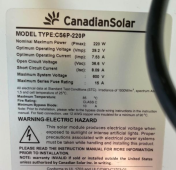Hello Everybody,
New to solar and to this website. I am looking at setting up a glamping site with a 20' shipping container. I am wondering if the WP recommended system in this link would meet my needs.
It uses a Growatt SPF3000 TL LVM-48p with a single rackmount LiFePO4 battery. My needs would be:
1. Midea 8000 btu AC - 750 watts. Most of the day
2. LED TV - 4-5 hours per day
3. Blu Ray player - 4-5 hours per day
4. Floor Lamp w/ 3 60 w bulbs. 4-5 hours per day.
5. Microwave - Several minutes per day
6. Hot Plate - Several minutes per day
What do you think, yes or no? And if it's yes, what do you think a good panel array to match up with that system. I would like to use the top of the container, which is 8x20.
Thanks in advance for any advice!
edit: my location is 84720 USA
New to solar and to this website. I am looking at setting up a glamping site with a 20' shipping container. I am wondering if the WP recommended system in this link would meet my needs.
It uses a Growatt SPF3000 TL LVM-48p with a single rackmount LiFePO4 battery. My needs would be:
1. Midea 8000 btu AC - 750 watts. Most of the day
2. LED TV - 4-5 hours per day
3. Blu Ray player - 4-5 hours per day
4. Floor Lamp w/ 3 60 w bulbs. 4-5 hours per day.
5. Microwave - Several minutes per day
6. Hot Plate - Several minutes per day
What do you think, yes or no? And if it's yes, what do you think a good panel array to match up with that system. I would like to use the top of the container, which is 8x20.
Thanks in advance for any advice!
edit: my location is 84720 USA
Last edited:



